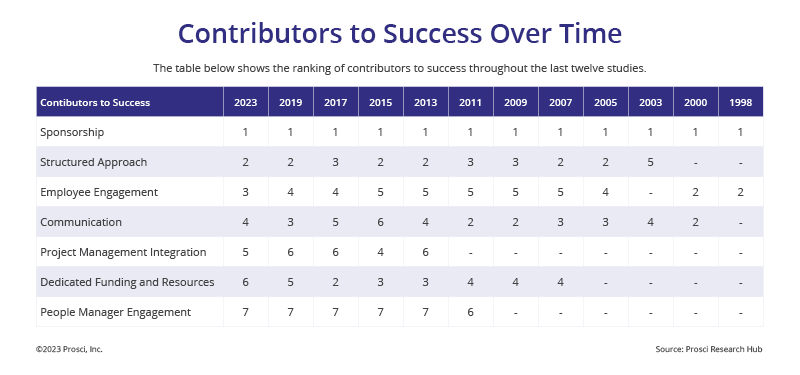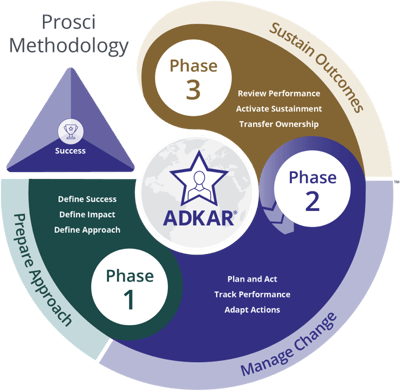Overcome Objections to Change Management

4 Mins
Updated: June 5, 2024
Published: July 9, 2015

Over the years, we have come across several common objections to change management, including the idea that change management is too "soft" or "fluffy" to matter to during project changes. Addressing this misconception is essential to bringing change management and its benefits into your organization.
If you hear someone say, "I’m responsible for the hard side of the project, not the soft stuff," you can take specific steps to address the objection to change management, based on its root cause. The most common root causes follow below.
1. No Connection Between Change Management and Project Success
Because the connection between the soft side of change and project success has not been made in the organization, there exists a critical lack of awareness of the impact and role of change management.
Research shows that change management directly contributes to projects meeting their objectives and achieving the ROI they expect. Help people in the organization make the connection.
 First, bring in research that shows the connection between effective change management and meeting project objectives, including Prosci Best Practices in Change Management research. Combine these resources with specific examples from your organization to show that the inability to manage the people side of change is one of the leading causes of failed changes.
First, bring in research that shows the connection between effective change management and meeting project objectives, including Prosci Best Practices in Change Management research. Combine these resources with specific examples from your organization to show that the inability to manage the people side of change is one of the leading causes of failed changes.
Second, present the ROI of change management. The ROI of change management is calculated based on three human factors: speed of adoption, ultimate utilization, and proficiency. The value a project ultimately delivers to the organization is tied to how quickly people adopt the change and how effectively they use the solution. This soft side of change impacts projects as much as the solution design.
2. Lack of Sponsorship for the Importance of Change Management
Prosci Best Practices in Change Management research consistently sshows that the number one contributor to successful change is active and visible sponsorship.
When you ask a project team to apply and engage in change management, you are asking them to alter the way they do their jobs, e.g., asking employees to use an online form for their expense and benefits process, or a new project management software. To get project teams and leaders to begin using change management on their projects, you need to use the same change management process you are asking them to apply.
In other words, you need to apply change management processes and principles to implement the change of "using change management on projects." Active and visible sponsorship is the number one success factor and must be present if you expect your project teams to begin integrating change management activities into their project activities.
When project teams are unwilling to take responsibility for the soft side of change, it can be due to a lack of sponsorship. Coaching your primary sponsor on their role and importance during change will help you overcome this objection to change management.

3. Fear, Discomfort, or Lack of Knowledge Required for Success
Many project members and leaders may not know what it means to manage the people side or soft side of the project.
A common misconception is that change management is the fluffy stuff or the soft side of the project, and that it has a vague starting point. You need to show project managers that change management is not chaotic—it is a proven management process with specific actions, tools and techniques for accelerating change within an organization.
Like project management, change management has a defined structure and methodology. The most effective way to demonstrate the definition of change management is to actively engage the group in change management training. The training should include actual work on a specific project that project teams bring to the course.
Have the team develop the change management strategy, conduct assessments, and develop plans for their specific project. This enables the group to grasp the effect change management will have on a project, experience the structured change management process, and develop the knowledge, ability and framework to start applying change management to their project quickly.
4. Nobody is Accountable for Change Management
In some organizations, even if there has been an acknowledgement of how change management contributes to project success, accountability for managing the people side of change has not been assigned to anyone. To ensure effective change management on new initiatives and projects, you need explicit accountability.
During Phase 1 - Prepare Approach of the Prosci 3-Phase Process, teams consider the structure of the change management team. Be cautious if you are looking at separating the accountability of the project and change management aspects, as the two are very closely connected.

5. Project Responsibilities Have Been Split
It may be the case that the responsibility for the hard and soft aspects of the project have been split, so this objection to change management may be true. In this situation, there must be a very close relationship between the people who have the hard and soft responsibilities.
The soft side (people side) and hard side (technical side) of change need to work together to integrate their plans and ensure that project activities are supporting the change efforts and that change management activities are supporting the project implementation.
Prosci Unified Value Proposition
Project teams are ultimately responsible for delivering value to the organization through their project. If the project requires people to change the way they do their jobs, the soft side is also the project team's responsibility.
Note that it is important to analyze why the responsibilities were split in the first place. Splitting the responsibilities may not be the best approach and may have resulted from someone not making the connection between change management and the project's outcome.
6. The Organization Has No Change Management History
Change management has grown tremendously since its inception, but remains unknown in some organizations and parts of the world.
If your organization has not applied change management in the past, you should provide specific company examples of changes that were more successful when they managed the people side of change.
You can also discuss specific examples of failed changes in your organization that would have benefitted from change management. Ask project teams to think about a recent project they worked on that did not meet its expectations. Were the root causes related to the hard side of the project or the soft side?
Use Data to Overcome Objections
to Change Management
Data from Prosci's Best Practices in Change Management research shows significant growth in participants using a structured approach and methodology for change management—from 34% to a 71% over the last two decades. Yet, many many organizations and project teams continue to object to participating in what they perceive as the soft side of change. Because project teams are a key source of information and crucial partners in efforts to integrate change management and project management activities, understanding and overcoming objections will help facilitate your efforts to apply change management with project leaders and team members.



